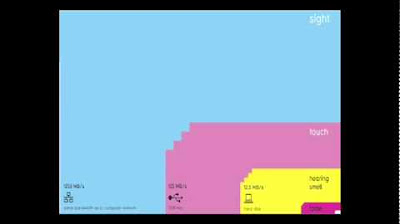The beauty of data visualization - David McCandless
Summary
TLDRThe speaker addresses the issue of information overload by advocating for the use of visual data representation to discern patterns and connections. They present various data visualizations, such as the billion-dollar-a-gram image, which contextualizes large financial figures, and a landscape of global media panic, revealing hidden patterns. The talk highlights the power of visualizing data to alter perspectives, change behaviors, and even enhance personal understanding of complex subjects like politics and health. The speaker concludes by emphasizing the role of information design in solving societal information problems and the beauty of data when presented visually.
Takeaways
- 📊 Visualizing information is a powerful tool to make sense of large amounts of data, revealing patterns and connections that are not immediately apparent.
- 💰 The 'billion dollar a gram' image illustrates the relative scale of financial figures reported in the news, showing how visualization can provide context and meaning to abstract numbers.
- 🌍 A landscape of global media panic visualizes how fears change over time, with patterns emerging from the data that are not obvious from reading news reports alone.
- 🎮 The regular pattern of concern over violent video games corresponds with the release of new games and significant historical events, showing how visualization can uncover hidden temporal patterns.
- 🌐 The phrase 'data is the new oil' is challenged, with the speaker suggesting 'data is the new soil', a fertile ground for creativity and innovation.
- 🌼 Data visualization is like flowers blooming from a fertile medium, transforming raw data into something beautiful and insightful.
- 📈 The speaker's visual CV demonstrates how personal information can be presented in an engaging and visually interesting way.
- 🧠 Exposure to information design has instilled a kind of 'dormant design literacy' in many people, making us all capable of understanding and appreciating visual information.
- 👀 The human eye is extremely sensitive to patterns and variations, and visual information is processed effortlessly, making it an effective way to communicate complex ideas.
- 🌍 Absolute figures can be misleading; relative figures connected to other data provide a fuller picture and can change perspectives, as demonstrated with military budgets and the number of soldiers.
- 💡 Visualization can compress knowledge, making it easier to understand and interpret large amounts of data, and can even lead to changes in behavior or mindset.
Q & A
What is the main idea presented in the transcript about dealing with information overload?
-The main idea is that using our eyes to visualize information can help us see patterns and connections, making it easier to understand and focus on what's important. Visualizing data can also make it more engaging and aesthetically pleasing.
What frustration led the speaker to create the 'billion dollar a gram' image?
-The speaker was frustrated with the meaninglessness of reported billion-dollar amounts in the press without context. By creating a visual representation, they aimed to provide a better understanding of these figures.
How does the 'billion dollar a gram' image help in understanding large financial figures?
-The image scales boxes according to reported financial figures and uses colors to represent the motivation behind the money, allowing viewers to see patterns and connections between numbers that would otherwise be scattered across multiple news reports.
What is the significance of the 'landscape of the world's fears' visualization?
-The visualization represents the intensity of certain fears over time as reported in the media, showing how public perception of threats like swine flu, bird flu, and asteroid collisions changes and how real events can overshadow other concerns.
How does the speaker use data visualization to find hidden patterns?
-The speaker uses data visualization to highlight odd regular patterns, such as the annual peaks in concern over violent video games coinciding with the release of new games and significant events like the Columbine shooting.
What is the metaphor used by the speaker to describe the relationship between data and its potential for insights?
-The speaker adapts the metaphor 'data is the new oil' to suggest that 'data is the new soil', a fertile creative medium that can be cultivated to produce new insights and innovations.
How does the speaker's visual CV convey their professional journey?
-The speaker's visual CV uses blocks of color and simple design elements to represent their transition from programming to writing and eventually to design, emphasizing their self-taught approach to design.
What does the speaker suggest about the impact of visual information on our perception and understanding?
-The speaker suggests that visual information is effortless to process and can provide relief in navigating dense information. It can also change our perspective and views, making complex data more accessible and understandable.
How does the speaker use data visualization to explore the relationship between military budgets and GDP?
-The speaker compares absolute military budget figures with GDP to provide a more nuanced view of military spending relative to a country's economic capacity, revealing different insights than looking at raw numbers alone.
What is the purpose of the 'balloon race' visualization of nutritional supplements?
-The 'balloon race' visualization aims to show the relationship between the efficacy of various nutritional supplements, based on the amount of evidence, and their popularity, allowing viewers to quickly assess which supplements are worth investigating.
How does the speaker describe the process of creating a visualization of the political spectrum?
-The speaker describes it as an attempt to understand how political ideas flow from government to society and back, and how visualization can help one see different perspectives and even recognize conflicting viewpoints within oneself.
What role does the speaker see for information design in addressing societal information problems?
-The speaker sees information design as a means to solve information problems such as overload, lack of trust, and skepticism, by providing elegant solutions that can quickly convey clarity and insights.
Outlines

This section is available to paid users only. Please upgrade to access this part.
Upgrade NowMindmap

This section is available to paid users only. Please upgrade to access this part.
Upgrade NowKeywords

This section is available to paid users only. Please upgrade to access this part.
Upgrade NowHighlights

This section is available to paid users only. Please upgrade to access this part.
Upgrade NowTranscripts

This section is available to paid users only. Please upgrade to access this part.
Upgrade NowBrowse More Related Video

The beauty of data visualization | David McCandless

The Assertion-Evidence Structure for PowerPoint Slide Design

Kejayaan, Kejatuhan dan Kebangkitan Kembali Extrajoss

How to spot a misleading graph - Lea Gaslowitz

MINI-LESSON 5: Correlation, the intuition. Doesn't mean what people usually think it means.

איך לכתוב קורות חיים?
5.0 / 5 (0 votes)